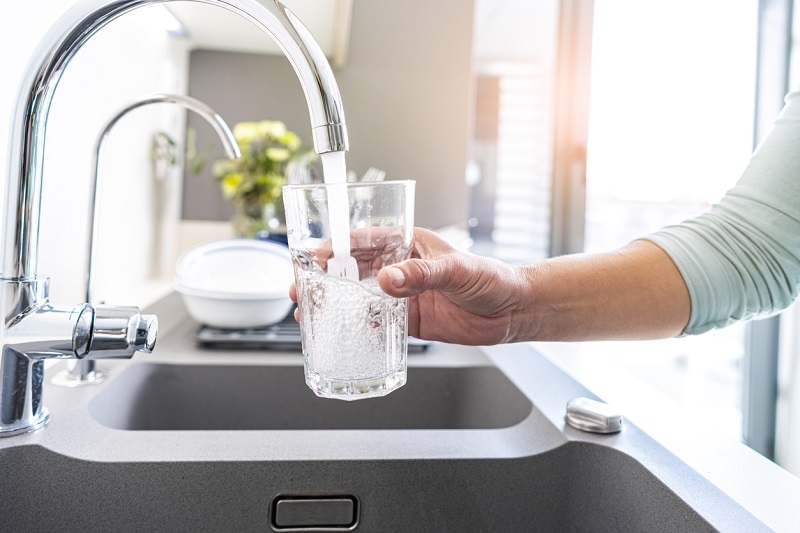Are PFAS Harmful & Can They Be Filtered From Water?

April 15, 2024
You pour yourself a glass of tap water. It looks clean and refreshing. But is it? What if that water is doing your body more harm than good?
If you’ve seen the news about “forever chemicals” in drinking water, it’s easy to distrust its safety. What exactly are you exposing yourself to every time you take a sip?
Over 70 million Americans rely on water systems where levels of toxic "forever chemicals,” or PFAS, have been detected.
What are PFAS and What Makes Them Harmful?
PFAS, or per- and polyfluoroalkyl substances, are a group of man-made chemicals that can cause severe problems in the human body. Research has linked them to many health issues, including cancer, immune system problems, female infertility and developmental issues in children.
PFAS are highly durable — they don’t break down, so they can build up in the body over time. They’ve been used in different industries for decades, showing up in our drinking water, food, nonstick cookware, firefighting foam, and items that are stain-resistant or water-repellent.
These chemicals can leach into the soil and groundwater, eventually finding their way into our drinking water sources. PFAS can also enter water bodies through industrial discharges or wastewater treatment plants.
An estimate from the U.S. Geological Survey found that nearly half of the country's tap water has at least one harmful chemical. Tests conducted by Consumer Reports found PFAS in 117 out of 120 water samples taken from taps nationwide. More than a third of those samples exceeded the level that Consumer Report's scientists deemed acceptable as the maximum.
"Pediatricians have serious concerns about the impact of PFAS on children's health,” says Lawrence Rosen, M.D., associate professor of pediatrics. “The best strategy — for all environmental toxins — is primary prevention, avoiding exposure in the first place."
How Can You Avoid PFAS in Drinking Water?
While you can’t control the leaching of PFAS into drinking water, you can control whether your water is filtered before you drink it.
Option A: Filtration Systems
Invest in a water filter that’s certified to remove PFAS:
- Activated carbon filters are one effective option, as they can adsorb PFAS molecules from the water.
- Reverse osmosis systems, another water treatment process, are another popular choice, capable of removing a wide range of contaminants, including PFAS.
- Some advanced filtration systems combine multiple techniques to ensure thorough removal of PFAS and other pollutants.
“Be mindful that most of the filters out there aren’t designed to filter out PFAS,” says Kyle Tafuri, vice president of sustainability at Hackensack Meridian Health. “But thankfully, more and more PFAS-filtering products are coming on the market, which is good.”
When choosing a water filtration system, look for products specifically certified to remove PFAS. NSF International and the Water Quality Association provide certifications for filtration systems, ensuring they meet stringent standards for contaminant removal.
For more purchasing guidance, turn to credible resources like the Environmental Working Group.
Option B: PFAS-Free Bottled Water
Another method is to switch to bottled water labeled as PFAS-free or sourced from locations with low PFAS contamination. Here’s how to do it:
- Check the brand's website or contact the manufacturer directly.
- Look for information about the water source and any testing or filtration processes used to ensure water quality.
- Some bottled water brands may also provide reports or certifications indicating low levels of PFAS contamination.
Each of us should try our best to take a proactive approach to ensuring that drinking water is safe. Do your research but pay close attention to your sources.
“Look to the independent bodies that are endorsing certain products, and don’t take what every company is saying at face value,” advises Tafuri. “Consumer Reports' Guide to Better, Safer Drinking Water is a great resource.”
Safeguarding Your Water to Protect Your Health
While the abundance of PFAS in water systems is alarming, there are steps you can take to protect yourself and your loved ones.
The ideal way to reduce your exposure is to invest in a certified water filtration system. This will also help you to avoid other health concerns related to drinking from plastic water bottles. If that’s not an option for you, choose PFAS-free bottled water. By staying informed and choosing safer products, you can contribute to a healthier future where clean drinking water is accessible to all.
What you eat and drink affects more than how you feel. It affects your health and longevity. Water consumption plays a huge role in safeguarding your health. Stay vigilant, stay informed, and sip smarter for a healthier tomorrow.
Next Steps & Resources
- Meet our source: Kyle Tafuri, Vice President of Sustainability
- To make an appointment with a doctor near you, call 800-822-8905 or visit our website.
- Learn more about better, safer drinking water.
The material provided through HealthU is intended to be used as general information only and should not replace the advice of your physician. Always consult your physician for individual care.






